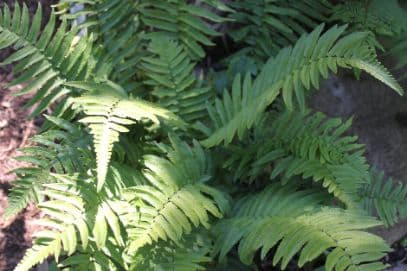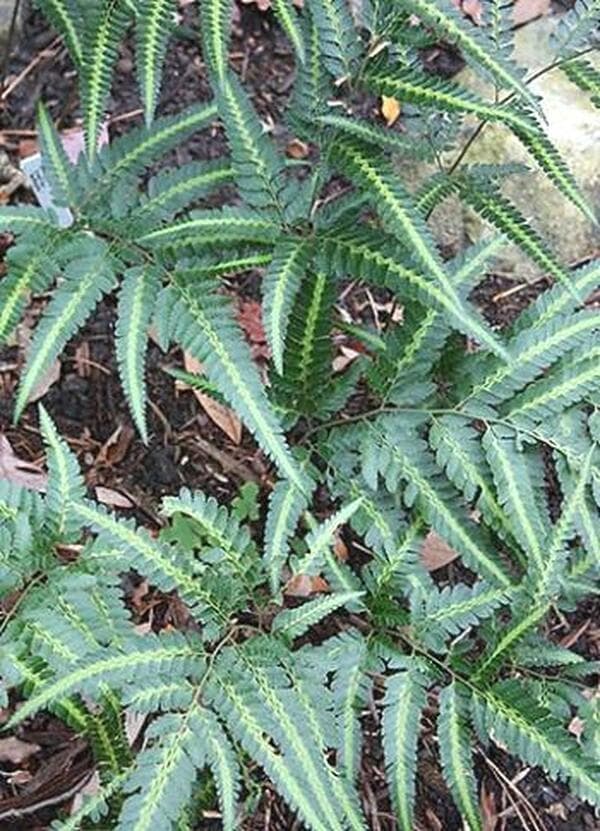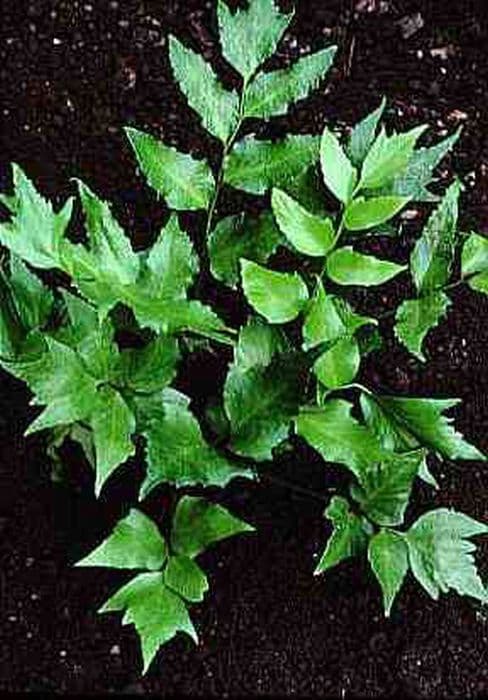Autumn Fern Dryopteris erythrosora

ABOUT
Autumn fern, the common name for Dryopteris erythrosora, displays an appealing variety of hues in its foliage throughout different times of the year. This plant is characterized by fronds that unroll from tight spirals, often referred to as fiddleheads due to their distinctive shape. These young fronds are especially eye-catching for their bronzy-pink to reddish color when they first emerge, giving the plant its common name as they evoke the warm tones found in the autumn. As the fronds mature, their color transitions to a deeper green, creating a lush, textured appearance. The lance-shaped leaves are divided into smaller leaflets that line the fronds' sides, curving slightly inwards and giving the plant an elegant, feathery look. The leaflets themselves have a delicate, slightly serrated edge with a subtle sheen, which can catch the sunlight and create a soft, radiant effect in the garden. The robust and leathery leaves adhere to the upright, arching stems, contributing to the dense and verdant aspect of the foliage clump. This makes the autumn fern an attractive, evergreen presence in any space that it resides, offering year-round visual interest through its vibrant color changes and graceful structure.
About this plant
 Names
NamesFamily
Dryopteridaceae.
Synonyms
Autumn Fern, Japanese Shield Fern, Japanese Wood Fern, Copper Shield Fern.
Common names
Aspidium erythrosorum, Dryopteris erythrosora var. prolifica, Dryopteris nipponica, Nephrodium erythrosorum.
 Toxicity
ToxicityTo humans
The Dryopteris erythrosora, commonly known as the autumn fern, is not known to be toxic to humans. There is no well-documented toxicity associated with ingesting the fronds or any other part of this particular fern. While it isn't advisable to consume any plant not known to be edible, accidental ingestion of the autumn fern typically does not lead to poisoning or serious complications.
To pets
The Dryopteris erythrosora, or autumn fern, does not have a known toxicity to pets such as cats and dogs. The ingestion of this fern is not typically associated with poisoning symptoms or severe health consequences. However, it is always advisable to prevent pets from ingesting non-food plants, as they may cause minor gastrointestinal upset or could have individual allergic reactions not widely documented.
 Characteristics
CharacteristicsLife cycle
Perennials
Foliage type
Evergreen
Color of leaves
Varies
Height
1-2 feet (30-60 cm)
Spread
1-2 feet (30-60 cm)
Plant type
Fern
Hardiness zones
5-9
Native area
East Asia
Benefits
 General Benefits
General Benefits- Ornamental Appeal: Its coppery-red young fronds create a striking visual interest in gardens.
- Easy Care: Dryopteris erythrosora, commonly known as the autumn fern, is a hardy and low-maintenance plant that grows well in a variety of conditions.
- Shade Tolerance: The autumn fern thrives in shaded areas where other plants might struggle.
- Soil Erosion Control: Its root system helps to stabilize soil, reducing erosion in sloped or delicate areas of the garden.
- Habitat Support: It provides habitat and shelter for local wildlife, such as birds and beneficial insects.
- Drought Resistance: Once established, autumn ferns can tolerate periods of drought, making them suitable for xeriscaping.
- Seasonal Interest: It offers year-round interest with its changing foliage colors through the seasons.
- Non-Invasive: Unlike some other fern species, the autumn fern does not aggressively spread, making it easier to control in a garden setting.
 Medical Properties
Medical Properties- This plant is not used for medical purposes.
 Air-purifying Qualities
Air-purifying QualitiesThis plant is not specifically known for air purifying qualities.
 Other Uses
Other Uses- Dryopteris erythrosora, commonly known as Autumn Fern, can be used in floral arrangements; its fronds provide a lush, green backdrop for a variety of cut flowers.
- The Autumn Fern is often utilized in terrariums and vivariums for reptiles and amphibians due to its tolerance of high humidity and low light conditions.
- This plant's dense foliage offers shelter and nesting materials for small garden fauna such as birds and beneficial insects.
- Autumn Ferns can be planted for erosion control on slopes or banks as their root systems help to stabilize the soil.
- Landscapers may use the plant to create a 'ferny' texture in shady garden spots to complement rough bark or rocks in landscape design.
- In art, the fronds of Autumn Ferns can be used for natural printing or eco-dyeing textiles, creating unique patterns and colors.
- This fern is utilized in educational settings like schools or botanical gardens to illustrate fern life cycles or spore propagation.
- It can act as a filler plant in garden beds, providing lush greenery to offset more colorful but seasonal perennials.
- Autumn Fern can be grown in hanging baskets to create trailing green cascades in shaded porch or patio areas.
- The plant is used in theme gardens, such as woodland or fairy gardens, to enhance the mystical, forest-like ambience.
Interesting Facts
 Feng Shui
Feng ShuiThe Autumn Fern is not used in Feng Shui practice.
 Zodiac Sign Compitability
Zodiac Sign CompitabilityThe Autumn Fern is not used in astrology practice.
 Plant Symbolism
Plant Symbolism- Endurance: Dryopteris erythrosora, also known as autumn fern, exhibits a vibrant display of colors that change with the seasons. Its ability to thrive in changing conditions symbolizes endurance and resilience.
- Subtlety: The autumn fern grows in a quiet, unassuming manner, which reflects a symbolic meaning of subtlety and grace.
- Rejuvenation: As it renews its fronds annually, the autumn fern is often associated with rejuvenation and new beginnings.
- Protection: Ferns in general, including the autumn fern, are commonly believed to possess protective qualities, often used in gardens to create a sense of shelter or sanctuary.
 Water
WaterThe Autumn Fern should be watered deeply once or twice a week, depending on the climate and the moisture level of the soil. It is important to keep the soil consistently moist but not waterlogged. During active growth in spring and summer, you might need to water more frequently. Generally, applying about one gallon of water per plant each time you water should suffice. In the fall and winter, reduce the frequency as the plant's growth slows down, ensuring the top inch of soil is dry before watering again.
 Light
LightAutumn Fern thrives in partial to full shade. It is best to position the plant in a spot where it receives filtered sunlight or light shade throughout the day. Avoid direct sunlight exposure, which can scorch the fronds, especially during the hottest part of the day.
 Temperature
TemperatureAutumn Fern prefers a temperature range between 60 and 75 degrees Fahrenheit for optimal growth. It can survive minimum temperatures down to about 50 degrees Fahrenheit and maximum temperatures up to around 80 degrees Fahrenheit. Avoid placing the fern in locations where temperatures dip below this range for extended periods to prevent cold damage.
 Pruning
PruningAutumn Ferns require minimal pruning, mostly to remove any dead or damaged fronds to maintain their appearance and encourage healthy growth. Pruning is best done in the spring before new growth begins. Typically, pruning once a year is sufficient. It's also a good time to remove any old fronds that may have become discolored or unsightly during the winter.
 Cleaning
CleaningAs needed
 Soil
SoilAutumn fern prefers a well-draining soil mix rich in organic matter with a pH of 5.5 to 6.5. A mix of loam, peat, and pine bark can provide the ideal structure and nutrients for this fern.
 Repotting
RepottingAutumn ferns should be repotted every 2 to 3 years to refresh the soil and accommodate the growth of the plant, ideally during spring before the onset of the growth season.
 Humidity & Misting
Humidity & MistingAutumn fern thrives in high humidity levels, typically between 60% to 80%, which mimics its natural forest habitat.
 Suitable locations
Suitable locationsIndoor
Place Autumn fern in indirect light with high humidity indoors.
Outdoor
Grow Autumn fern in shaded area with moist soil outdoors.
Hardiness zone
5-9 USDA
 Life cycle
Life cycleAutumn fern, Dryopteris erythrosora, begins its life cycle as a spore that germinates to produce a tiny heart-shaped gametophyte, which is the sexual stage of the plant. The gametophyte houses both male and female reproductive organs and can self-fertilize or cross-fertilize with other gametophytes, leading to the production of a zygote. The zygote then develops into a young fern, known as a sporophyte, which is the dominant and most visible stage of the fern's life cycle. The sporophyte grows and matures, producing distinctive fronds that unfurl in a coiled shape known as fiddleheads. These fronds exhibit a striking bronze-pink color in the spring, turning green as they mature. The mature sporophyte eventually produces clusters of spore-bearing structures called sori on the undersides of its fronds, thus completing the life cycle when these spores are released into the environment.
 Propogation
PropogationPropogation time
Spring to Summer
The Autumn Fern, or Dryopteris erythrosora, is commonly propagated by the division of rhizomes, which is ideally done in the spring just as new growth begins. The most popular method involves carefully lifting the fern from the ground, ensuring not to damage the root structure. Once the plant is uplifted, use a sharp, sterilized knife or spade to divide the root ball into sections, each with an adequate amount of roots and at least one frond or growth point. These divisions can then be immediately replanted in soil that is rich in organic matter, kept moist, and provided with dappled shade, which replicates this fern's natural habitat. After planting, it is essential to water the divisions thoroughly to help establish them in their new locations. With proper care, these divisions will grow into healthy individual plants, each carrying the striking characteristics of the Autumn Fern.









